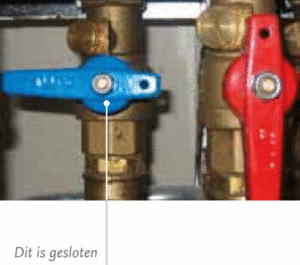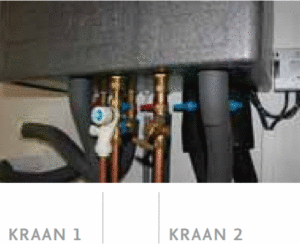Disruptions
2024
| Type of disruption | Date | Time and duration of disruption | Which consumers are affected? | Status |
| Gepland onderhoud – mogelijke onderbreking van warmte en/of warm tapwater | do 20 juni | 08:30 – 16:00 | Alle aansluitingen | – |
| Leveringsonderbreking warmte en warm tapwater |
Zo 21- Ma 22 april |
Van ca. 15:15 (21-4) – 2:30 (22-4) (11,25 uur) | Alle bouwdelen behalve een deel van hartje Wenen en hartje Londen – ca. 450 aansluitingen | Resolved |
| Leveringsonderbreking warmte en warm tapwater | Zo 21- Ma 22 april | Van ca. 15:15 (21-4) – 18:30 (22-4) (27,25 uur) | Een deel van bouwdelen hartje Wenen en hartje Londen – ca. 50 aansluitingen | Resolved |
Een overzicht van alle historische storingsmeldingen vindt u terug op www.inwarmte.nl/storingen.
Our energy supply is more reliable than, for example, a central heating boiler. But of course something can happen that makes you not completely satisfied. Do you have a problem? Then read below what you can do best to have the problem solved as soon as possible. On this page you can also read how we can best answer your question.
What should you do in case of calamities, malfunctions or questions?
There are different ways to reach us.
Option A
Is your problem urgent?
Call 085 – 130 48 29
Is your problem not urgent?
Then it is best to send an email to vragen@inwarmte.nl
Option B or C
Please send an email to vragen@inwarmte.nl
Option D
Warm Hartje Eindhoven cannot solve or answer your problem, complaint or question. The problem is not our responsibility or our products or services do not cause the problem. In this case, you must follow the instructions given to you by your landlord/seller. Or consult the manual or internet site provided by your own installer or service provider of your landlord.
Questions about calamities and malfunctions
- Be careful because the water can be hot!
- Immediately close all valves (red and blue) under the delivery set.
You can find out how to do this in the manual behind Index 3, Chapter 3.5.

Doesn't the leakage decrease significantly?
Close the cold water supply at the drinking water meter in your home. This drinking water meter is probably located in the meter cupboard or other location provided by the homeowner/seller.
- Choose option A
Is the leakage decreasing?
Check that the leakage comes from the delivery set or from the rear 5 connecting pipes. If this is the case:
- Choose option A
Is the leakage coming from the front pipes of the delivery set or somewhere else in your home?
Then there's most likely a problem in the indoor installation:
- Choose option D
Is the leakage the result of work carried out on your behalf, such as drilling or nailing in floors or walls?
Then it's most likely a problem in the indoor installation:
- Choose option D
Does the smoke and/or strong fire/scorch come from the delivery set?
- Choose option A
Does the smoke and/or strong fire/scorch smell come from the components under or next to the delivery set or at a location elsewhere in your home?
Then there's most likely a problem in the indoor installation:
- Choose option D
Do these drops occur during the hot summer months and is your home cooled?
Then there's probably condensation. Try to prevent damage caused by this condensation by, for example, placing a cloth or a receptacle. Will dripping continue for a longer period of time, even at lower outside temperatures or when your home is not cooled?
- Choose option A (not urgent)
Do these droplets/small leaks occur in situations other than those mentioned above?
- Choose option A (not urgent)
Most likely there's a problem in the indoor installation
- Choose option D
You'll probably need to vent the indoor installation:
- Choose option D
Try to find out where the sound comes from.
In many cases the ventilation unit is placed next to our delivery set. The chance that a ventilation unit suddenly causes a noise problem is greater than our delivery set.
It is also possible that the CV pump will cause a noise problem under the delivery set (see figure 1.a, behind index card 3).
Is the noise problem indeed caused by the ventilation unit, heating pump or something else besides the delivery set?
- Choose option D
It is common for the delivery set to make a hissing sound. The flowing water causes this noise.
Is the sound suddenly much louder?
- Choose option A (not urgent)
Is the sound so loud that it causes nuisance to you and your environment?
For example, you can't sleep with it or your neighbours can hear it?
- Choose option A (not urgent)
There is most likely a problem with the supply of drinking water.
Ask if your neighbours have a similar problem.
- Choose option D
Check if the two taps (white and copper as shown in the illustration) are fully open (turn anti-clockwise).

No result?
- Choose option A (not urgent)
Check several taps such as the shower/bath faucet but also the kitchen faucet. The thermosstatic bath or shower faucet can cause the problem.
Is the problem not found at all taps?
Then there's most likely a problem in the indoor installation:
- Choose option D
If the above does not apply: Ask if your neighbours also have a similar problem.
Is this the case?
In that case, there may be a temporary disruption / limitation in the delivery and the problem will resolve itself within a few hours.
Doesn't the problem resolve itself within a few hours?
- Choose option A (not urgent)
The indoor installation causes this problem.
- Choose option D
Ask if your neighbours have a similar problem.
Is this the case?
-
- In that case, there may be a temporary disruption / limitation in the delivery and the problem will resolve itself within a few hours.
-
- Check if all valves under the delivery set are open. You can read how to do this in the manual behind tab 3, chapter 3.5.
- Controleer op de verbruiksmeter of er een volumestroom aanwezig is en controleer de aanvoertemperatuur (deze dient bij warmtelevering > 30oC te zijn). In de handleiding achter tabblad 3, hoofdstuk 4.1, kunt u lezen hoe u dit kunt controleren. Raadpleeg de aansluitvoorwaarden achter tabblad 5 om te kunnen bepalen of er warmte of koude geleverd moet worden en welke temperaturen ongeveer geleverd zouden moeten worden.
-
Have you not found any strange things with the above checks?
Then there's most likely a problem in the indoor installation:
- Choose option D
In all other cases:
- Choose option A (not urgent)
The indoor installation causes this problem.
- Choose option D
The indoor installation causes this problem.
- Choose option D
